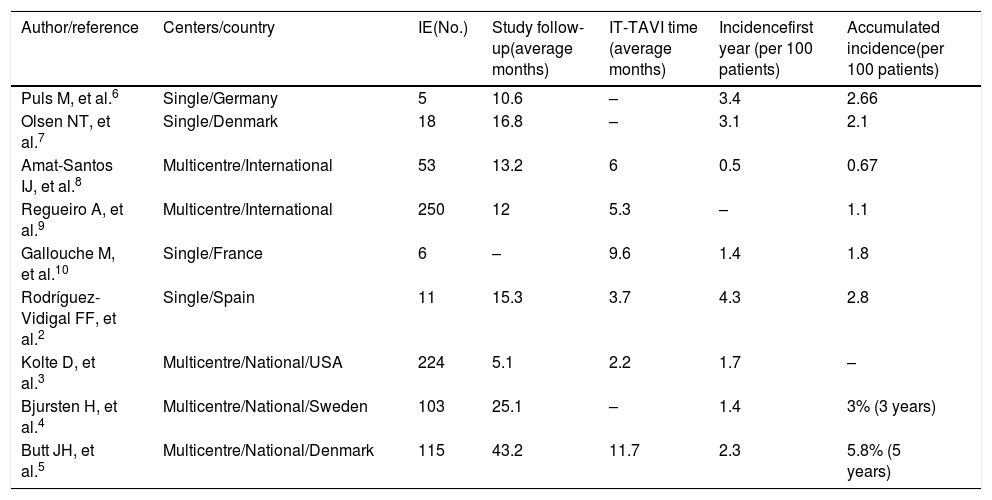We appreciate the reflections provided by Sánchez-Ledesma et al.1 in their letter, as they draw attention to a highly important aspect, antimicrobial prophylaxis, and invite us to study the factors that influence the disparate incidences observed in infective endocarditis on transcatheter aortic valve implantation (TAVI).
Since the acceptance of our article,2 in September 2018, new multicentre series of infectious endocarditis on TAVI (E-TAVI) have been published (Pubmed: tavi [or tavr] and infective endocarditis).3–5Table 1 expands the incidence data collected in the above-mentioned study with these series.6–10 Overall, we can see that the disparity in the duration of follow-up after TAVI could partly explain the differences in the cumulative incidence, along with some factors related to case collection. It should be noted that, regardless of the incidence in the first year post-TAVI, in the series with a longer follow-up, higher accumulated incidences are reached.5 And, as we proposed in our work, the estimation of E-TAVI may be more reliable from prolonged follow-up of the TAVI cohort of a hospital (or nation),5 than if cases already diagnosed with E-TAVI for one year are included in a multicentre study.9 In addition, in the multicentre series, there may be a selection bias for hospitals that have already passed the learning phase.
Duration of follow-up and incidence of infective endocarditis on TAVI.
| Author/reference | Centers/country | IE(No.) | Study follow-up(average months) | IT-TAVI time (average months) | Incidencefirst year (per 100 patients) | Accumulated incidence(per 100 patients) |
|---|---|---|---|---|---|---|
| Puls M, et al.6 | Single/Germany | 5 | 10.6 | – | 3.4 | 2.66 |
| Olsen NT, et al.7 | Single/Denmark | 18 | 16.8 | – | 3.1 | 2.1 |
| Amat-Santos IJ, et al.8 | Multicentre/International | 53 | 13.2 | 6 | 0.5 | 0.67 |
| Regueiro A, et al.9 | Multicentre/International | 250 | 12 | 5.3 | – | 1.1 |
| Gallouche M, et al.10 | Single/France | 6 | – | 9.6 | 1.4 | 1.8 |
| Rodríguez-Vidigal FF, et al.2 | Single/Spain | 11 | 15.3 | 3.7 | 4.3 | 2.8 |
| Kolte D, et al.3 | Multicentre/National/USA | 224 | 5.1 | 2.2 | 1.7 | – |
| Bjursten H, et al.4 | Multicentre/National/Sweden | 103 | 25.1 | – | 1.4 | 3% (3 years) |
| Butt JH, et al.5 | Multicentre/National/Denmark | 115 | 43.2 | 11.7 | 2.3 | 5.8% (5 years) |
IE: infective endocarditis; TAVI: transcatheter aortic valve implantation.
The time sequence of our 11 cases of E-TAVI can help explain the high incidence in the first year (4.3%): 7 of the 11 cases occurred in the first year after the procedure. On the other hand, there is an accumulation of endocarditis on TAVI implanted during the months of February and March 2013 (5 out of 11), when the collection period spanned from 2009 to 2017. This fact may be related to a change made in the conditions of the procedure that became more complex due to the intervention of several specialists within the room: an anesthesiologist to intubate, a vascular surgeon for femoral access and a radiologist for ultrasound.
We agree with Sánchez-Ledesma et al.1 on the importance of screening for nasal carriers of Staphylococcus aureus prior to the procedure. In our center we observed how, after the implementation of a set of preventive measures, which included treatment with mupirocin for nasal carriers of S. aureus, the incidence of surgical wound infection in cardiac surgery was reduced by 58% (from 3.6 to 1.5%; p=0.04) and the measure was extended to the hemodynamic unit. But we cannot forget the importance of being alert to other potential sources of infection, given the participation of Enterococcus spp. and Streptococcus as aetiological agents of E-TAVI,7–9 so measures such as the cleaning of groin areas and avoidance of catheterisation could be relevant.
In conclusion, the prevention of nosocomial infection is essential and we must continue collecting, comparing and sharing data to better understand how E-TAVI cases develop and how to avoid them, without forgetting that a similar methodology is required in the collection of cases in order to properly compare incidence.
Please cite this article as: Rodríguez-Vidigal FF, Nogales-Asensio JM, Calvo-Cano A, López-Minguez JR. Endocarditis infecciosa sobre TAVI: la necesidad de trabajar en equipo para mejorar los resultados. Respuesta. Enferm Infecc Microbiol Clin. 2020;38:250–251.







